Interior decoration of the house from vulture panels. Exterior cladding of a house from vulture panels
Houses made of SIP panels, after the completion of the construction phase, seem almost ready for life. And yet, before entering such a house, you need to carry out a number of mandatory work:
- interior wall decoration with plasterboard,
- wiring and connection of electrical equipment,
- carrying out plumbing works,
- ventilation device.
All these works are necessary for a normal and healthy life in a new home. The Second House company offers a comprehensive and fast solution to this problem.
First of all, you need to understand why these works are necessary at the first stage.
Plasterboard wall decoration - the basis of fire safety and subsequent finishing
The timber frame of the building and the self-supporting insulated wire panels are combustible materials and although fires very rarely occur in the walls themselves, the walls must be protected from the penetration and spread of fire. To do this, you can use any non-combustible material: gypsum plasterboard, gypsum fiber boards, gypsum fiber board, fiber cement or glass magnesite sheets of LSU. GCR of these materials is the cheapest. For reliable protection and high-quality finishing, it is advisable to sheathe in two layers, and it is necessary to sheathe not only the walls, but also the lower surfaces of the floors.
Drywall is also an excellent base for finishing. It is perfectly putty, primed, painted and pasted over.
Sheathing needs to be done directly to the surfaceOSB, of which the SIP-panel consists. At the same time, electrical lines are divorced.
External electrical wiring - the basis of safety and heat saving
In houses made of SIP panels, the solution is unambiguous: the wiring should not be immersed inside the SIP. This is dictated not only by the norms of electrical work in wooden houses (in the West, electricity is often conducted inside SIP panels), but also by the need to maintain a sealed thermal circuit.
Fortunately, plasterboard or similar trims allow outdoor electrical wiring to be created in an inconspicuous way.
For this, wires in a corrugation, cable duct or in double insulation are carried out strictly vertically in a layer of drywall.
In the case of complex finishing we do this simultaneously with the plasterboard wall cladding.
Plumbing work in SIP houses
Our company has developed standard water and sewage distribution schemes adapted for SIP houses. Before concluding a contract, we approve detailed project works on the "VK" section, which guarantees both us and the customer that we will get exactly what we expected.
The project is free for the customer. At the same time, such problems as water quality and filtration stages, volume of consumed water, distribution along risers, etc. are immediately solved.
Ventilation in a modern home is the foundation of health
The house is made of SIP panels, like most high-quality modern houses, requires good ventilation. Many architects, when designing houses with insulated walls and sealed glass units, still focus on natural supply ventilation... It only shows low level domestic architectural qualifications.
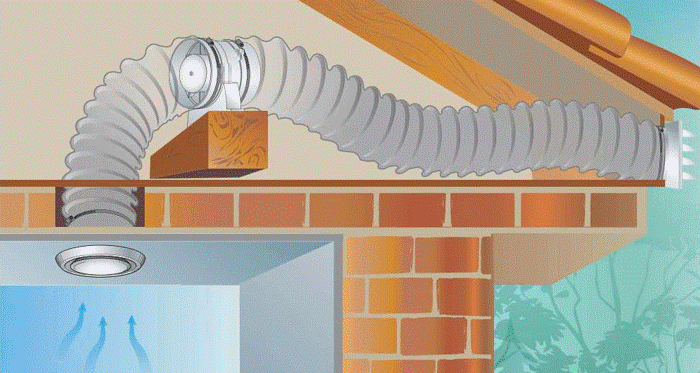 Breathable walls in the Russian climate can only be created for summer wooden houses or for houses with a huge energy consumption by modern standards (roughly speaking, where it blows from everywhere).
Breathable walls in the Russian climate can only be created for summer wooden houses or for houses with a huge energy consumption by modern standards (roughly speaking, where it blows from everywhere).
For a healthy life, the air in the house must constantly circulate from the external environment to the living quarters (bedrooms, living rooms) to technical ones (kitchens, bathrooms, boiler rooms), from where it must be removed, preferably without loss of heat. Residents must adjust the flow rate depending on whether the space is being used or not.
A good ventilation system can be both expensive and relatively cheap. In the first case, the system is controlled automatically and retains heat well; in cheap options, you spend more energy, because no heat return occurs, and must regulate the supply ventilation themselves.
Our company has real experience in installing various types of ventilation in houses from self-supporting insulated wire and we are ready to implement it in your home.
Complex interior finishing - saving you money
Complex carrying out finishing works beneficial not only to the customer, but also to our company. We create a single project, optimize transport and overhead costs, do all the work in a single schedule.
Therefore, when combining works, we always offer a discount and additional bonuses: free installation of a shield or a fan pipe.
Contact our specialist and ask him all the questions that you already have. Choose the form of communication: by e-mail or by phone. Leave your coordinates and we will contact you.
Interior decoration of a house made of SIP panels is not much different from the same type of work in any other building. Its only way, which is inappropriate to produce in such a house, is wet plaster with lime-sand mortar. All other types of finishes are much easier to produce in it than in a brick or block house. Although, if you set a goal and approach it creatively, you can make such a plaster by sewing up the frame from the inside with cement-bonded particle boards, priming them and sealing the seams. But whether such tricks are worth the dubious advantages of the result that crowns these efforts, you decide. We will consider options that are both more expedient and less expensive. And we divide them according to the types of materials that cover the wall cake from the inside.
Often materials are used that are themselves a finish. So the wall cake can be closed:
- painted, polished, treated with impregnations or stains with a false beam, block house, wooden lining;
- wood-fiber panels (MDF) or plastic panels (PVC) installed on the crate;
- sheet materials based on fiberboard and chipboard with a finished finishing layer (lamination, embossing, PVC film, etc.).
Depending on the design of the walls as a whole, you may have material from the inside that requires finishing:
- oSB plate;
- gypsum plasterboard (gypsum plasterboard);
- magnesite slab;
- cement-bonded particle board;
- aquapanel other.
- These cases will be considered in detail.
Finishing OSB walls in a frame house
Often, it is this material that closes the cake of the wall of the house made of SIP panels, both outside and inside. This is due to its high manufacturability. Actually, it was for this type of construction that it was created, but still, more as a constructive, and not finishing material... Although there are known cases of its use as a finish interior decoration coated with varnish and decorative fasteners.
If you like the texture, color of the OSB and the manufacturer did not think of sticking all the information about yourself and your products directly to its front side, you can safely use this panel if environmentally friendly glue was used as a binder in its manufacture. And almost as boldly, but coated with appropriate varnishes or paints to prevent the release of harmful substances that make up the glue. After all, we use chipboard cabinet furniture. And there - everything is the same, but in much higher concentrations.
The main feature of any house where wood is used as a frame is that when the humidity changes, it reacts to this by changing the linear parameters. That is, with an increase in humidity, the connecting bar in the SIP panel or the frame stand, on which two OSB sheets are connected, will slightly increase in size, which will inevitably lead to the formation of cracks. And there are two methods of struggle:
- close the joint with some kind of decorative overlay;
- fill the joint with elastic material that compensates for its dimensional fluctuations, in color with OSB or vice versa - contrasting with it, emphasizing the construction of the house.
We want to warn in advance that when plastering walls from OSB directly with any compounds, gluing the seams with a mesh will not completely solve the problem of cracking, but only reduce it. Alternatively, you can use ready-made super-elastic plasters or liquid wallpaper, which, due to their structure, largely hide the process itself, but do not eliminate it.
From a technical point of view, the most correct solution to this issue can be gluing drywall sheets to OSB boards on polyurethane glue or polyurethane foam, but without rigid attachment to the frame and with a shift in the joints. Here they can be glued with a "serpyanka" and do whatever the soul desires with the wall: paste over with wallpaper and fabrics, plaster, paint with structural or ordinary paint, glue tiles or apply any kind decorative plaster... And from a fire-prevention point of view, such a decision will be correct.
Finishing of walls from gypsum board
Yes, this is exactly what in many countries of the world, when building houses from SIP panels and much more common than in our country, they do it. On the inside, the cake is covered with a thick (24 mm or even more) plasterboard panel and it is already finished with something beautiful.
But, firstly, you will not find such people with fire during the day, and secondly, this also does not completely remove the problem of moisture changes in the wooden frame. But it only makes them less noticeable due to better gluing of the seams to the thickness of the material and the ability to dampen dimensional fluctuations on the fasteners, due to the relative softness of the material.
Our recommendations, in this case, will be reduced to gluing together two 12.5 mm gypsum boards using the same adhesives. In this case, the first sheet can be attached to the frame using self-tapping screws for drywall. It will cover your insulation and create the foundation for your wall finish. If PSB is used as a heater, vapor barrier is not needed, if cotton wool is required, and in this case it must be screwed on.
On it, we also recommend performing a gutter for electrical wiring. The pliability and workability of this material makes it easy and simple, and in the presence of a manual electric milling cutter, also with a song from its electric motor. Slitting is performed to a depth of 5-6 mm. You can also build a manual wall chaser, similar to that used for reinforcing aerated concrete, only smaller. In addition to polyurethane adhesives, to connect two sheets of drywall together, you can use adhesives based on the same gypsum, in a fairly wide range presented in Russian building stores. Apply them under a comb-trowel in a thin layer or in small patches and not thickly either.
But before you stick the second sheet of gypsum board after wiring, we strongly recommend going around the whole house with a camera and tape measure. How does this help in the future to avoid annoying (expensive, and sometimes life-threatening) misunderstandings when trying to drive a nail in the places where the electric wire passes.
And it is in this section that it should be mentioned that if you want to stick wallpaper on drywall, you must immediately plaster it with a thin layer. Otherwise, if you try to replace them with new ones after a certain number of years, you may learn a belated but serious lesson in economy and thrift. It is almost impossible to tear off the old wallpaper from the paper surface of the gypsum board.
Options for finishing the walls of self-supporting insulated wire at home
The materials we mentioned in the introduction, quite exotic in our country, which are sometimes still used for the walls of self-supporting insulated wire (SIP) houses, differ little from the two main ones described in sufficient detail above in application options.
Simply, if you use glass-magnesite plates, remember about their rather high fragility and about the possibility of connecting them to each other using ordinary tile glue. At the same time, they are no less convenient and technologically advanced in work than drywall.
Cement particle boards, in which more than half of the composition is cement, are extremely rarely used for interior decoration of premises due to their large weight, and heavy processing with a sufficiently large fragility. But if, nevertheless, for some reason they were chosen, the main materials, both for gluing and for sealing joints and plastering, will be cement-based adhesives and plasters. It is better to use the most elastic of them for sealing joints.
Aquapanels have appeared on our market not so long ago and have not yet managed to occupy any significant niche on it. These cement slabs are mainly intended for outdoor use in frame construction systems, but sometimes they are installed in the interior of a house with high humidity. The system is good in that it has accessories for installation and finishing of the same manufacturer: from the ceiling version to putty, but it is bad for its cost.
An elegant, but expensive option for ultra-modern wall decoration at home is the use of printed stretch ceiling systems on them. At the same time, what closed the wall cake is not a subject of discussion in principle.
Also recently, a fairly large number of molded and sheet products for interior decoration with new names have appeared, which are often variations on the theme of the main materials already listed, with various types of coatings. When using them, it is important not to forget about the main problematic feature of houses with a wooden frame and you will be happy in it.
Dear readers, if you have any questions, ask them using the form below. We will be glad to communicate with you;)
Erection frame houses made of sandwich panels, consisting of OSB-boards with a layer of insulation, has long gained wide popularity. Such houses are built quickly, do not need additional insulation, do not require a technological break to shrink before finishing.
On the contrary, SIP panels are cladding as quickly as possible so that their surface is not affected by weather. What materials are used for the exterior and interior decoration of these houses?
Despite the fact that OSB boards, which are the basis for SIP panels, are considered a waterproof material, it is better not to tighten them with finishing for the following reasons:
- Over time, panels made on the basis of wood chips begin to darken from exposure to sunlight, which does not affect their appearance in the best way. And if you leave them unprotected for several years, then constant contact with moisture will begin to act destructively on them;
- The cladding provides additional sound insulation and protects the interior from overheating. Finishing with an air gap between the cladding and the walls is especially effective in this regard;
- The surface of this wall material is not attractive enough to leave it exposed. The cladding gives a finished look to the entire structure, both inside and outside.
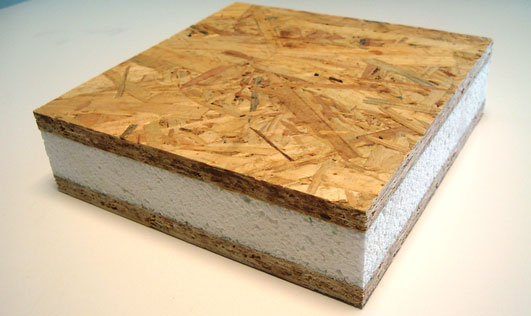
What are good about such houses is the exceptional simplicity of any type of decoration. Almost perfectly flat walls do not require leveling, which greatly simplifies the installation of cladding materials and reduces the time spent on work.
Choice of materials
In addition to such material characteristics as its service life, price, appearance, fire safety, etc., the choice depends on the operating conditions. Simply put, on which walls you are going to finish - internal or external.
For facade cladding
The indisputable advantage of houses built from SIP panels is unlimited choice. You can use any finish, from plaster to modern composite panels, focusing only on your taste and financial capabilities.
Let's take a closer look at the most popular options:
- Plaster. This method is rarely used to beautify the facades of such houses, since it is simply not economically viable. High-quality plaster is expensive, as well as the work on its application, and it is difficult to do them with your own hands.
Council. If you nevertheless chose this type of exterior decoration, you must strictly follow the technological sequence of work. They consist of the following stages: priming the surface with a composition with antiseptic additives, installing a reinforcing fiberglass mesh, basic surface plastering, applying decorative flexible plaster.
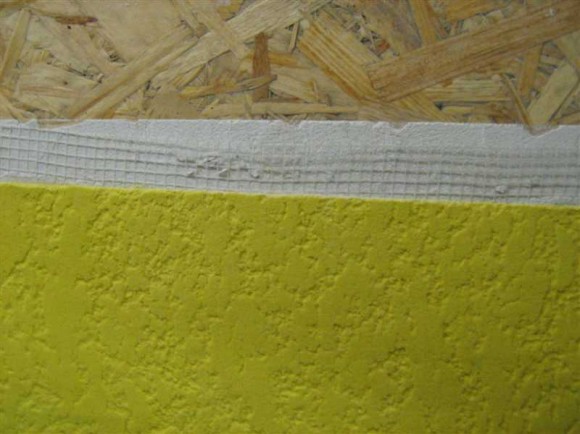
- from SIP panels with siding. Any type of siding is suitable for creating a facade - vinyl, metal, fiber cement, basement. Since the base is flat, it will be very easy to mount the frame for fixing it.
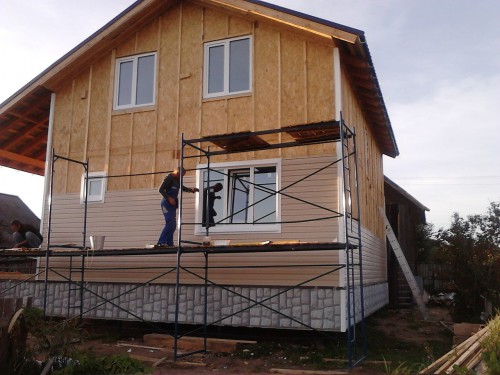
- Polymer, very naturally imitating these materials, are also quite often used to decorate such facades, allowing them to be transformed beyond recognition. Compared to cladding with real bricks and stones, it is cheaper and faster.
- Transform frame house in stone it is possible with the help of panels made of cement-sand mixture with various additives. It is very difficult to distinguish them from natural stone even on closer inspection.
Note. Cement panels are heavy, so the foundation must be strong enough to support the additional load.
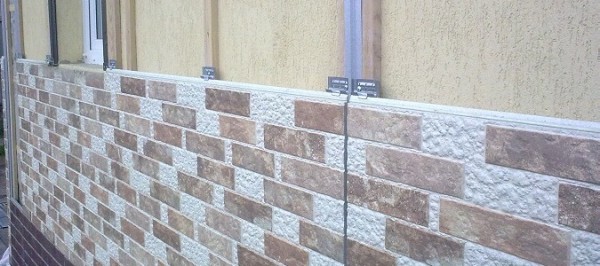
- Facing with clinker tiles and artificial stone will allow you to create a strong, reliable and durable coating, but it will be very expensive, since a huge part of the cost is surface preparation - reinforcement and basic plaster with special compounds.
- Composite sandwich panels for finishing such houses are used, if desired, to provide the building with more powerful protection against freezing in winter and overheating in summer.
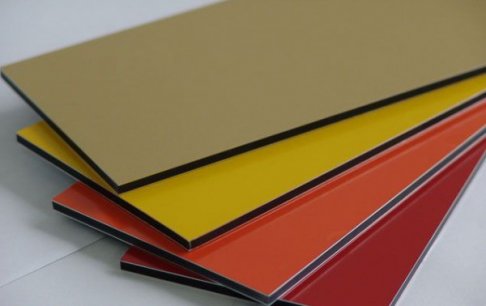
In addition to these, there are many other facade materials that can be used to revet SIP panels and cladding with any of them will cause much less difficulties than when decorating brick, panel or log houses.
For interior decoration
In heated rooms with a stable temperature and humidity regime, there is no need to protect the walls from freezing or exposure to snow and rain. The aesthetic side of the issue is more important here.
And there are people who are quite satisfied with how the walls look without decoration at all.
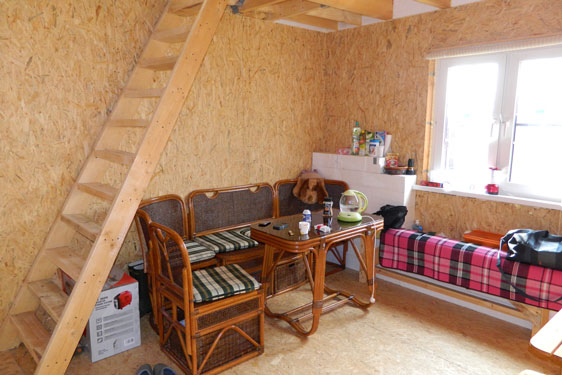
Since the walls are very smooth, their main task becomes design decoration... And here, too, all known finishing methods are suitable.
- Putty. It is necessary if you are going to paint the walls, since without preliminary preparation, the paint compositions are not able to level the rough surface of the plates, even after several layers of primer. Before puttying, the joints between the panels are sealed with masking tape.
Surface preparation instructions must be followed exactly:
- In the same way, the walls are prepared for wallpapering.
- There is also a radically different way - instead of putty, the walls are sheathed with plasterboard or LSU, which is screwed directly to the base, without a frame. Further, any options for decorative finishes are possible, from painting to tiling with appropriate surface preparation.
Note. Plasterboard cladding improves heat and sound insulation, and also reduces the degree of fire hazard of the building.
Of course, in our case, such finishing methods as cladding with plastic or MDF panels, as well as other similar materials, are also possible. After watching the video, you will see how easy it is to do this work.
Conclusion
Many modern builders choose a sandwich panel based on oriented strand board as the main building material for walls. This is due to both the high heat-saving qualities of the material, and the ability to build a house with minimal costs and in a short time.
Last but not least, options for future finishes are being considered, and in this respect this material is out of competition, since SIP panels can be clad with anything, without waiting for the building to shrink.
SIP panels are a wide selection of modern building materials that have a multi-layer structure. Panels are used in the construction of houses using Canadian technology. The panels are based on OSB particle boards. A layer of expanded polystyrene is located between them. When the installation of the panels is over, you have to take care of the external finish, which would not be affected by weather conditions and have an attractive appearance.
If you decide to use SIP panels for building a house, then you must first decide on the choice of material for decoration. Today, no problems should arise with this, since there is a wide range of these products. But what a ventilated facade looks like, and how you can install it yourself, this will help you understand
A rock
Using this construction material, it is possible to execute outer skin houses. They use a stone for partial finishing of SIP panels or for facade works... By its structure and colorist a natural stone differs, but this does not affect the characteristics of the structure in any way.
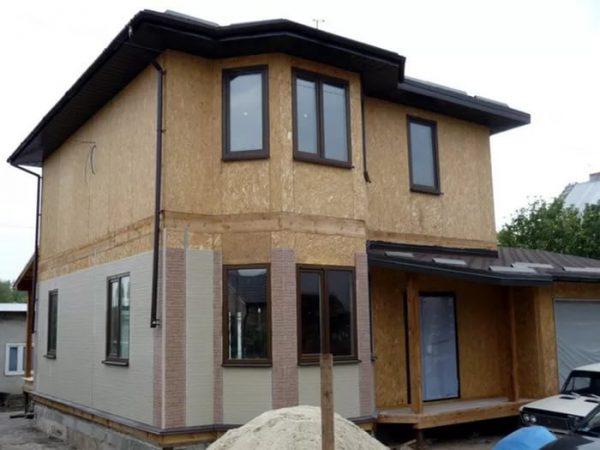 Decorating a house from vulture panels with stone
Decorating a house from vulture panels with stone The advantages of the stone include: a low level of heat conductivity and excellent performance of sound and heat insulation. But how the stone facing tile is used, you can see
Eco-friendly block house
The facade of a house made of SIP panels is often decorated using wooden lining. The finish is very similar to a log cabin, because natural wood is used for its manufacture. The block house is based on a rounded log, and its sides are cut from 4 sides. Houses built from SIP panels and finished with a block house gain strength and reliability.
But what is the design of the facade country house, and how to choose what you need, you can see
On the video decorating a house from vulture panels with a block house:
Plaster
This option for finishing the facade is considered the most popular. And this is not surprising, because this material has attractive view and at the same time its cost is low. There are several types of plasters used for the facade: silicate, cement, acrylic and silicone.
On the video, decorating a house from vulture panels with plaster:
As for the disadvantages, cement plaster does not have such a wide range. colors... Silicate plaster remains the next most popular. It is perfect for facade decoration. It is based on only natural ingredients that are linked to each other using liquid potassium stele. The disadvantages of this material include the high cost. But how to put lighthouses under plaster, and how to do all the work, this will help you understand
Facade from DSP
The front part of the house, made of CBPB, is a cement slab containing shavings and chemical additives. The advantages of this material include size. House cladding does not carry anything complicated. This business will take you several hours. In addition, this material is environmentally friendly. In its composition there are no harmful additives, it is easy to cut, and it also does not lend itself to the influence of weather and fire.
On the video finishing of a house made of vulture DSP panels:
OSB panels
This option for decorating houses is considered modern today. This is OSB based siding. It is less brittle compared to fiber cement siding. In addition, it does not lend itself to the influence of temperature extremes, which cannot be said about vinyl siding. In the photo - OSB-based siding:
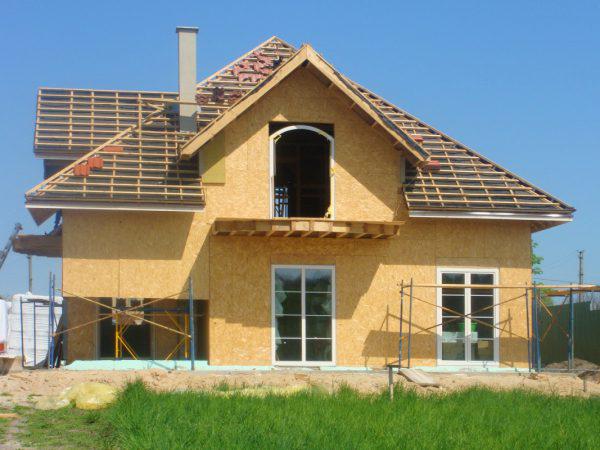 House facade decoration from OSB vulture panels
House facade decoration from OSB vulture panels You can use this material option instead of a wall, since the panel design assumes the presence of an external wall and siding at the same time. To give the finish an original look, you can paint the material in any color you like. To create a rich and luxurious finish, the type of material in question is imitated under a tree. And here is what houses from metal sandwich panels look like, you can see
How to install
The cladding of the facade of the house from SIP panels originates from the installation of the first plank. It needs to be fixed around the entire perimeter of the house on the crate. The procedure is as follows:
- Attach the first plank with screws with a pitch of 30 cm. At the same time, you must take care of a 5-6 mm gap between the sections of the initial punks, which is fixed evenly and strictly horizontally.
- Set the outer corner at the junction of two walls, and use screws for fastening. Screw them into the corresponding and existing grooves on both sides. After that, be sure to make sure that the angle setting is correct.
- External corners can be presented in various types and differ in size, shape and installation options.
- After the outer corners have been installed, you can proceed to the installation of the panels on the facade.
- The installation process runs from left to right. Installation of the first panel is carried out flush into the corner of the first plank. For fixing it is worth using screws.
- The next strip is installed in the bracket of the previous panel. Thus, a chain of front panels of the first row is formed.
- Each subsequent row should start from left to right and after the first row of planks. Next, the second and further rows are built in.
- External cladding of a house from SIP panels can be carried out with various facade panels. If you use the transition from one type to another, then for these purposes you will have to use the platbands. In this case, they will play a decorative role.
But how the facade cladding with porcelain stoneware occurs, and what you should pay attention to during the work, this
On video exterior decoration houses from vulture panels:
SIP panels - an innovative approach in the construction industry. The houses thus obtained are distinguished by their pleasant appearance and high durability. But the finishing touch is the exterior finish. For this, various materials can be used, each of which differs in its operational and decorative qualities.
The construction of frame structures from SIP panels is a relatively new direction in the domestic sphere of construction services. Such structures are assembled faster than classic houses made of bricks or cinder block and practically do not shrink in the first years after completion of construction, therefore, the interior decoration of houses from SIP panels can be done immediately after the objects are put into operation.
SIP boards are a construction sandwich consisting of two OSB sheets, between which there is a layer of expanded polystyrene. The technique of interior cladding of walls assembled from such panels involves the execution of rough and finishing work, the implementation of which requires adherence to a certain technology.
Rough finishing of a house from SIP panels
The walls of buildings made of SIP plates, as a rule, have the correct geometry and do not need to be leveled, so the main task is to prepare the surfaces for decorative finishing. To do this, it is necessary to close up the panel joints, refine window slopes and remove the ribbing characteristic of all OSB sheets.
For finishing the seams, a painting net is used, which is covered with wood putty. For the treatment of joints in bathrooms or kitchens, where breakdowns are likely with further spillage of water, it is more advisable to use an acrylic sealant. This putty is used to treat the seam and the lower part of the wall, where a strip 15-20 cm wide is formed. Such a treatment will reliably protect the walls from unwanted moisture.
Since OSB boards have relatively low adhesion, it is not so easy to remove the ribbing by means of conventional plastering. The best option for creating a smooth surface suitable for finishing with topcoats is gypsum plasterboard (GKL) wall cladding.
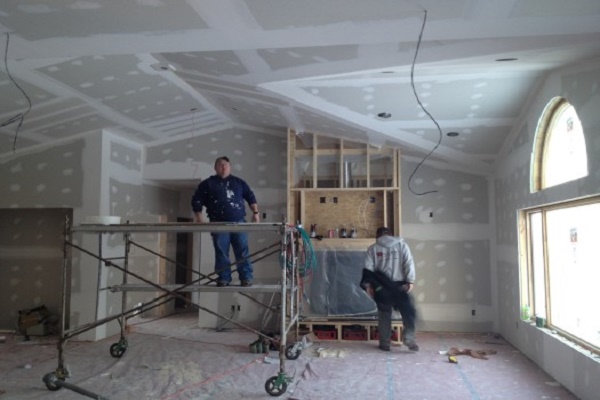
The advantages of sheathing the premises of self-supporting insulated wire at home using gypsum board:
- allows you to hide engineering networks (electrical wiring, telephone and antenna cables),
- increases the performance of sound insulation,
- simplifies the process of applying wall decoration,
- improves the fire safety of the building.
As a result of the installation of a frame, on which gypsum plasterboards will subsequently be mounted, the useful volume of rooms is somewhat reduced. This circumstance is the only drawback of wall decoration by means of gypsum board.
Ceiling finishing
The choice of materials for finishing ceiling tiles in a house made of SIP panels depends only on the personal preferences of the owners of the building. Most often, suspended structures made of gypsum plasterboard are attached to the ceilings, plastic panels, lining or canvas of a stretch ceiling.
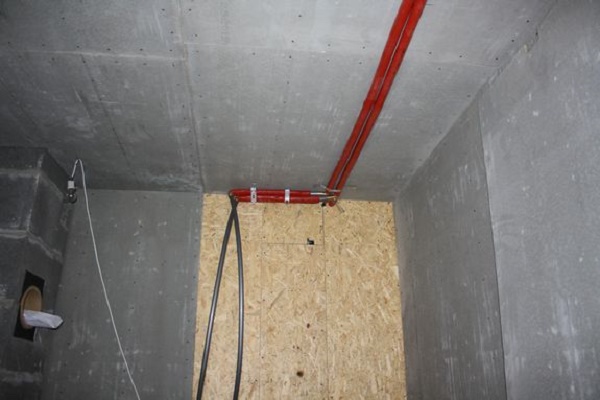
Each of these types of ceiling cladding is good in its own way, but they are all highly aesthetically pleasing and very easy to maintain. In addition, such suspended structures perfectly cope with the tasks of hiding ventilation ducts and electrical wiring laid along the ceiling.
Finishing the floor
Floor decoration in buildings made of SIP panels is carried out using all kinds of floor coverings:
- carpet,
- laminate,
- linoleum,
- parquet,
- tiles.
If ceramic tiles were chosen for the flooring, the OSB sheet must first be covered with a cement-bonded particleboard, which will ensure reliable adhesion of the tile to the floor. Unlike tiles, the process of laying coatings based on polymeric materials or wood is quick and easy, without much difficulty.
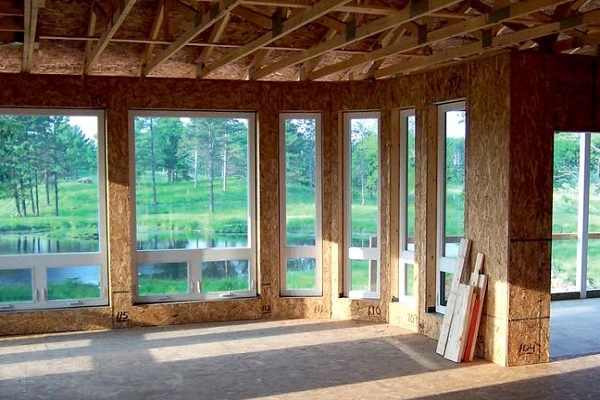
Since in wooden structures the sounds coming from different rooms are clearly audible throughout the house, when interior finishing of floors in multi-storey buildings assembled using Canadian technology, experts recommend additionally covering the floors on the upper floors with sound-absorbing materials.
Finishing walls
Finishing the walls involves the application of decorative coatings, as well as the installation of interior doors, electrical outlets, switches and lighting fixtures. The choice of wall decoration largely depends on the purpose of the room and the features of the design project.
For the interior decoration of walls in houses assembled using Canadian technology, the following materials are most often used:
- Decorative plaster. This coating is characterized by exceptional practicality and long service life. If the rough cladding was made with gypsum plasterboards, decorative plastering is done according to the classical technology. Otherwise, a plaster mesh must be attached to the surface to be treated with a stapler, on which a layer of starting plaster is applied. This is done in order to decorative finishing the relief of the OSB sheet did not appear. Only after the base coat has dried and sanded can the walls be covered with decorative plaster.
- Plastic lining. The main advantages of this material are its low cost, resistance to temperature extremes and moisture, as well as a long service life. When decorating walls with plastic clapboard, the surface to be decorated does not need to be sheathed with plasterboard, since the unevenness of the walls will hide behind the slats. The lining is attached to a special lathing, which can be easily built from ordinary wooden battens. Plastic lining is an economical and practical option for wall decoration of a house from SIP plates.
- Wallpaper. This type of wall decoration is considered the most popular. A wide range of wallpapers allows you to choose a cover for every taste and budget. The owner of the house can only choose the option that best meets the requirements for finishing a particular room. It is preferable to decorate the walls in the bedrooms with eco-friendly paper wallpaper. Kitchen finishes are best done with hard-wearing vinyls that can withstand multiple cleanings. In the living room, you can glue beautiful textured or textile wallpaper.
- Paint. The paintwork is considered one of the most durable and durable. Such a finish is not afraid of contact with water, therefore it can be used to decorate walls in rooms with high humidity.
- Decorative rock. Wall cladding with this material is one of the most time consuming and costly ways of decorating rooms. Decorative stone is used for zoning rooms, laying out a kitchen backsplash and facing doorways.
The interior decoration of houses assembled using Canadian technology practically does not differ from repair work in brick or concrete structures, but due to the fact that the perfectly flat surface of self-supporting insulated wire boards does not need additional preparation, decorating such houses will cost significantly less than arranging buildings erected from other building materials.



